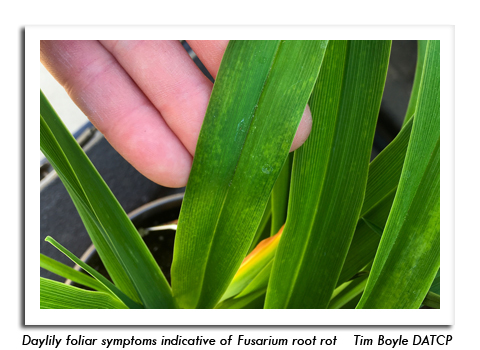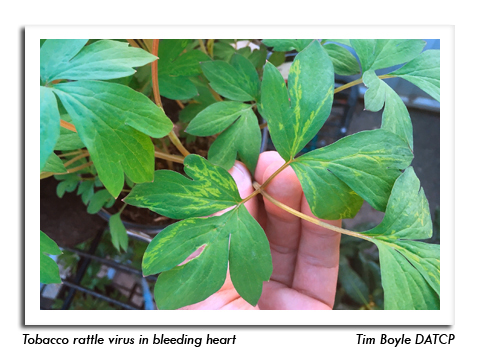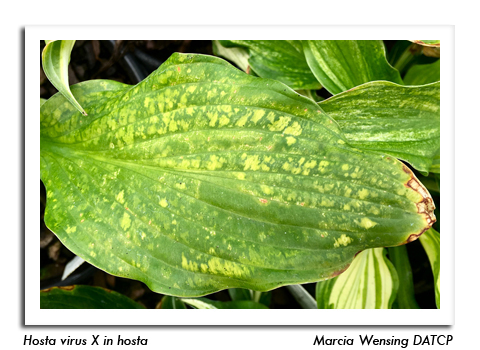
 |
|
|
Nursery & Forest
Volume 64 Number 4 Date 05/23/2019 ROOT ROT - Repeated rain along with mild days and cool nights brought reports of water-related plant issues from many areas throughout the state this week. Prolonged, excessive soil moisture from weather and overwatering have predisposed many container plants to rot diseases, with rhizoctonia crown rot, fusarium root rot, and rhizoctonia root rot trending at inspection sites statewide. In southeastern Wisconsin, ligularia 'Midnight Lady' was diagnosed with black root rot, while Pythium, a soft rot, was found on several iris species. Root-bound plants often show symptoms of rot diseases, as overgrown roots clog container drainage and exacerbate already-high environmental moisture problems. POWDERY MILDEW - The wet spring weather has also been favorable for powdery mildew on ornamentals. Plants infected with powdery mildew are characterized by patches of grayish-white powdery fungal spores, primarily on the upper leaves, which if not controlled cause foliage to yellow and senesce prematurely. Cultural practices to increase air circulation and reduce ambient moisture throughout the plant stock help to minimize mildew development. Chemical control through applications of copper-based fungicides may also be an option. PLANT VIRUSES - Nursery grower and dealer inspections this spring continue to find a plethora of plant viruses. Potyvirus species have been confirmed in lungwort 'Mrs. Moon,' sedum 'Autumn Joy', and spiderwort 'Zwanenburg.' In the Iris family, the Iris germanica cultivars 'Calypso Dancer', 'Lemon Pop', 'Libation', 'Treasured', 'Celestial Snow', 'Baboon Bottom', 'Whoopem Up', 'Girls Gone Wild', 'Campfire Tales', and 'Harvest of Memories' all tested positive for potyvirus at the state's Plant Industry Bureau Laboratory, as did Iris pumila 'Blue Denim'. Tobacco rattle virus (TRV) was found in bleeding heart varieties 'Gold Heart' and 'Valentine', in the astilbe cultivars 'Glut' and 'Purple Candles,' and in sedum 'Mr. Goodbud', which also tested positive for tobacco mosaic virus (TMV). An Ilarvirus, likely tobacco streak virus (TSV), was detected in astilbe 'Maggy Daley' and 'Visions in Red'. A begonia hybrid, 'Baladin' tested positive for impatiens necrotic spot virus (INSV), and hosta virus X (HVX) was diagnosed in the hosta hybrid 'Undulata albomarginata'. Plant viruses cannot be directly controlled by chemical application. Depending on the virus disease, the means of control include chemical or biological control of the virus's vector(s), prevention of viral establishment in previously uninfected stock, removal and proper disposal of infected plant materials, consumer education to recognize plant virus symptoms, and making an industry-wide effort to develop virus-resistant varieties and implement tighter virus-free certification standards. An extensive gallery of nursery plant virus symptoms, compiled by the DATCP Plant Industry Lab, can be found here. NON-VIABLE NURSERY STOCK - Nursery plants offered for retail sale should be assessed for viability next week. Plants not that are leafed out or showing live buds will be considered nonviable and cannot legally be sold after June 1. Trees and plants in late dormancy or which are suspected to revive late may be rehabilitated outside of retail sales areas and may be returned to sale when healthy, or must be destroyed or returned to the supplier. Plant materials shipped with plastic-wrapped roots such as dry bulbs, trees and shrubs are especially prone to moisture deficiency problems during transport and should be sold within three weeks of arrival at retail stores. - Tim Boyle, DATCP Nursery Inspector 



|
|
|